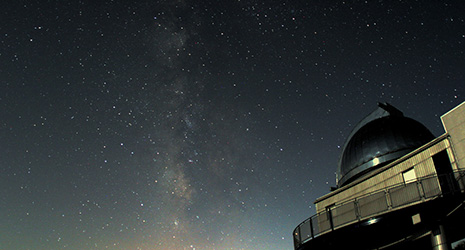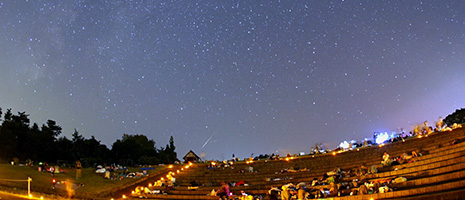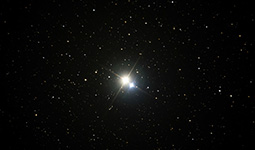February 2020
A Town With Bountiful Twinkling Stars

Having the highest number of days with clear skies in Japan, the Bisei Town area of Ibara City, Okayama, boasts beautiful starry nights and is visited by many people for astronomical observation.
In Ibara City, located in the southwestern part of Okayama Prefecture, is Bisei Town, a place known as the Beautiful Star. Just as the name suggests, the sparkling stars in the night sky are beautiful in Bisei, and the town is dotted with facilities for astronomical observation. Many amateur stargazers and fans of astronomy gather here. Among the facilities, the Bisei Astronomical Observatory has gained popularity as a place where anyone can casually enjoy stargazing.
Itoh Ryosuke, an engineer at the Observatory, says, “the Bisei Astronomical Observatory was opened in 1993 as a place for lifelong learning for city residents. In addition to residents of Ibara City, many people from neighboring Kurashiki City and Fukuyama City come to observe, as well. We also host events where ordinary people can casually enjoy the starry skies in addition to training and supporting the activities of amateur stargazers by loaning out large-scale telescopes at night, for example.”
From 6 pm on Friday through Monday each week, a Stargazing Party is held at the Bisei Astronomical Observatory. At this popular event, participants can observe the seasonal celestial bodies using a large 101 cm-diameter telescope, and every year, roughly 14,000 people attend. The event attracts many families and couples.

Inside the dome where the telescope is stored, the Observatory employee enters the desired celestial body into the computer and the telescope turns and changes directions while making a deep sound. Then the visitors each take turns taking a look through the lens. The employee explains, “What you are looking at is Albireo in the Cygnus constellation. This is the star that makes up the beak of the swan.” Out on the veranda that wraps around the outside of the dome, other employees are explaining the night sky using large binoculars and volunteers are explaining the constellations. There were a few clouds out on this night, but we were still able to see many stars, more than you could ever see while in town.

One man, who came with his wife and two elementary school children, gave his impressions of the Observatory, saying, “I myself like space, so I came today thinking I wanted to show the universe to my kids. I want to come again during another season as my kids have become interested.”
Itoh explains why astronomical observation has become popular in Bisei Town.
“There are three conditions for astronomical observation. They are: high amount of days with good weather, minimal air fluctuations, and a dark sky. It is well known that Okayama Prefecture has a high amount of days with good weather, but the Prefecture also has some of the most minuscule air fluctuations due to temperature change and wind in Japan. Because of this, private-public observatories were built in Kurashiki City in the 1920s, but the sky became brighter due to the effects of urbanization and the environment for making observations worsened, so Bisei Town in the mountains became the ideal spot for observations.”
Because of this history, an Optical Environmental Disruption (Light Pollution) Prevention Ordinance to preserve the beautiful starlit skies in Bisei Town was established and put into effect in 1989.
“The regulations have established rules, such as turning off all outdoor lights except for security lighting and other essential lights at 10 pm and keeping light from seeping out into the night by blocking it with curtains, for example, in places like offices where large amounts of light are used. At the Bisei Astronomical Observatory as well, we teach children who come to visit about the importance of maintaining a dark night sky.”
From 2019, the Bisei Tourism Association has taken center stage in working on activities for the Bisei Hoshimori Project. Specifically, they are working to change LED street lights to a color that has low light diffusion and are calling for vending machine lights to be turned off after 10 pm, among other initiatives. They are also aiming to receive Dark Sky Place recognition, a kind of World Heritage Site for starry skies, from the International Dark-Sky Association.
Itoh says he wants to leave behind a suitable environment for stargazing in the future through these kinds of initiatives.
“The beauty of the stars seen in the pitch black night sky is simply extraordinary. I want to share this splendor with as many people as possible.”

